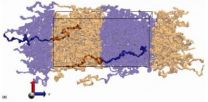(Press-News.org) CORVALLIS, Ore. – Dinosaurs squashed them with impunity. Thousands of species that lacked culinary appreciation have turned up their noses at them. And a study based on advanced DNA analysis has shown that this shameful indifference went on for 129 million years.
Finally, however, one animal species came along that would learn to appreciate this particular fungus with almost a global reverence – homo sapiens. Thus was born the human affection for the morel – for millions of people around the world, it's what you mean when you say "mushroom hunting."
Spring is coming soon, and with it the timeless quest for morels. For some, it's almost a way of life.
Nancy Weber, a researcher with the College of Forest Ecosystems and Society at Oregon State University, has had a lifelong love affair with the morel.
Her parents took her on her first mushroom hunt in the Michigan woods at the age of six months. Presumably they sat her down in front of a morel, wiped the drool from the corner of her mouth and said, "Now pay attention, Nancy. This is important. This is what you look for."
"Morels probably became so prized because of their distinctive appearance, which almost anyone can learn to recognize," Weber said. "That means you're not apt to pick a poison mushroom. But for a lot of people, mushroom hunting becomes part of your life, stories you tell around a campfire, a favorite picking spot whose location you hide like a great fishing hole."
Weber was part of a research team that has published one of the most detailed genetic analyses ever done on morels, to help identify their ancestry, show how they evolved and what conservation policies may be needed to manage and protect this valuable resource.
Among other things, they concluded that morels have been around for a lot, lot, longer than people have – true morels split off from all other fungal species 129 million years ago, during the beginning of the Cretaceous Period. Back then, mammals were primitive little things, dinosaurs still ruled the world and morels were kind of an afterthought.
Which pretty much proves that dinosaurs had small brains. Or lacked culinary skills.
Since then, morels have evolved into 177 related species, and western North America – particularly the Pacific Northwest – has been an evolutionary hot spot. Despite the varying species, in many ways morels have "remained remarkably static since the Cretaceous," the researchers said. The study was done by scientists from OSU, the U.S. Department of Agriculture, Eastern Illinois University and private industry. It was published in Fungal Genetics and Biology, a professional journal.
"Oddly enough, most animal species aren't particularly attracted to morels," Weber said. "A few slugs and other things will eat them. But humans have probably been eating them for about as long as there have been humans."
The morel, which usually grows a few inches tall but can get larger, is a harbinger of spring and often gives people an excuse to get outdoors after winter is over, Weber said. They can last much of the summer into early fall and provide plenty of opportunity for hiking up and down hills, peeking under leaves, and trying to convince yourself you have a special technique and understanding about how to find this often-elusive mushroom.
"There are things you can know about how to find morels, but on another level they are wherever you find them," Weber said. "When I was a kid, we once drove all over the place, hiked everywhere, came up empty-handed and then went back home, found a bunch of them growing under our apple tree next to the house."
Morels are, in fact, a delicacy, although cooking them doesn't need to be fancy – a few morels sautéed in butter with a little salt and pepper is difficult to improve upon. They are the people's mushroom – clearly more sophisticated than the ubiquitous and bland button mushroom sold in bulk at the grocery store, but not so fancy as the chanterelle prized in French cuisine or the matsutake favored for Japanese dishes.
People who eat morels usually have mud on their boots and aren't afraid to work for their prize.
Getting them can be as simple as a couple hours stomping around in the woods, or traveling hundreds of miles to compete in a mushroom hunting festival. Sometimes you get lucky and come home with a bag full. Often you don't.
"You can grow morels in confinement, but it's pretty tricky and unpredictable, and some people don't think they taste as good," Weber said.
In the Pacific Northwest, finding morels has even evolved into a cottage industry. One species is fairly common after a forest fire, leading to the odd phenomenon of crowds of people sometimes showing up in the spring in an area that burned the previous summer. Dried morels are now sometimes found in supermarkets or available on the Internet.
Based on the new genetic analysis, scientists now know that morels are very old, but not at all the oldest of 1.5 million species of fungi. They are found widely around the world, probably traveled with the continents as they drifted apart, but still look pretty much the same way they did millions of years ago.
There's one big difference now. At least one animal on Earth has finally come to appreciate them.
###
Editor's Note: A digital image of a morel is available at http://www.flickr.com/photos/oregonstateuniversity/5477764874/
By David Stauth, 541-737-0787
Contact: Nancy Weber, nancy.weber@oregonstate.edu
END
ALBUQUERQUE, N.M. — Sandia National Laboratories researcher Steve Plimpton, who led development of a widely used computer code that models how materials behave, has been invited to present a keynote lecture at the Feb. 27-March 3 Minerals, Materials & Materials Society (TMS) meeting in San Diego.
Plimpton developed the LAMMPS molecular-dynamics software code. The acronym LAMMPS (Large-scale Atomic/Molecular Massively Parallel Simulator) is also a pun on the word "lamp," a device that brings light to dark places.
"This symposium [on Massively Parallel Simulations of ...
A recent settlement involving the estate of the late Jacksonville financial adviser Wayne McLeod is the latest example of how legal complexities can encroach upon the timely resolution of an estate. At the time of his suicide, McLeod's financial services firm was under investigation by the Securities and Exchange Commission. This investigation revealed that McLeod's alleged financial planning prowess was actually a large "Ponzi" scheme.
A significant portion of McLeod's estate will now be used to repay the defrauded investors. McLeod's wife will keep some of her jewelry ...
Troy, N.Y. – Recent research by doctoral student Sevan Goenezen holds the promise of becoming a powerful new weapon in the fight against breast cancer. His complex computational research has led to a fast, inexpensive new method for using ultrasound and advanced algorithms to differentiate between benign and malignant tumors with a high degree of accuracy.
Goenezen, a student in the Department of Mechanical, Aerospace, and Nuclear Engineering at Rensselaer, is one of three finalists for the 2011 $30,000 Lemelson-MIT Rensselaer Student Prize. A public ceremony announcing ...
According to the Annual Workplace Class Action Litigation Report, the value of class action employment discrimination settlements has gone up substantially over the past year. The report notes that, in 2010, the value of the top ten settlements was $346 million. By comparison, the total value of the ten largest settlements in 2009 was $84.4 million.
The settlement in Velez v. Novartis Corp., a federal case from the Southern District of New York, accounts for over half of this years' total. The case was originally filed in 2004 by Amy Velez and four female coworkers who ...
Cornelius Dupree Jr. was recently released from prison after DNA testing revealed that he could not have committed the crime. After being convicted of rape and robbery, Dupree was sentenced to 75 years in prison in 1980. He spent 30 years maintaining his innocence. He would have been paroled had he admitted committing the crimes, but he refused. Finally, DNA testing of evidence cleared him of any wrongdoing.
Dupree's story is all too familiar in Texas. Dallas County leads the nation in DNA exonerations. The county has released 21 individuals who were convicted of crimes, ...
HUNTSVILLE -- Students from two university campuses in Texas and Washington recently were surveyed on allowing concealed handguns on campus.
According to research led by Dr. Jeffrey Bouffard at Sam Houston State University's College of Criminal Justice, more students were uncomfortable with concealed weapons on campus than those at ease with guns on college grounds. The study will be presented at the Academy of Criminal Justice Sciences Meeting in Toronto this month.
"To date, little effort has been made to assess students' opinions about whether concealed handgun carrying ...
There comes a time in life for every bird to spread its wings and leave the nest, but for gray catbirds, that might be the beginning of the end. Smithsonian scientists report fledgling catbirds in suburban habitats are at their most vulnerable stage of life, with almost 80 percent killed by predators before they reach adulthood. Almost half of the deaths were linked to domestic cats.
Urban areas cover more than 100 million acres within the continental the United States and are spreading, with an increase of 48 percent from 1982 to 2003. Although urbanization affects ...
New findings on how tuberculosis (TB) bacteria develop multi-drug tolerance point to ways TB infections might be cured more quickly.
The study will be published April 1 in the journal Cell. The results identify both a mechanism and a potential therapy for drug tolerance that is induced in the TB bacteria by the host cells they infect.
Currently, TB treatment requires a complex, long-term curative regimen of at least six months, explained the senior author of the study, Dr. Lalita Ramakrishnan, University of Washington (UW) professor of medicine, microbiology and immunology. ...
Teplis Travel, a premier corporate travel agency, recently attended the Concur Fusion 2011 No Limit conference. Held February 15-18, 2011 at The Cosmopolitan Hotel Las Vegas, this event brought together Concur clients, partners, and employees to exchange ideas and knowledge on products and services available to easily manage corporate travel and expenses.
Fusion 2011 session highlights included:
- Reviewing top expense features companies should be using
- Going global with travel
- Delivering value through integration with suppliers, customers and mobile applications
- ...
A new paper by University of Calgary researchers, published today in PLoS ONE, demonstrates the edge given to prey in the "space race" by human activity.
The research was conducted by two University of Calgary students, a University of Calgary Post-Doctoral Fellow and two University of Calgary professors from the Faculty of Environmental Design, Department of Geomatics in the Schulich School of Engineering and the Faculty of Veterinary Medicine. The research looked at how predator-prey interactions and use of space were influenced by human activity.
The team deployed ...


